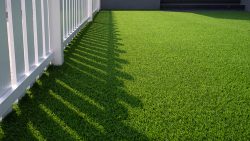Lawn Care 101: Tips for a Lush, Green Lawn
 Lawn Care 101: Tips for a Lush, Green Lawn
Lawn Care 101: Tips for a Lush, Green Lawn
Taking care of a lush green lawn requires effort and proper care. Even with the best of intentions, without the correct lawn care maintenance routine, your lawn can easily become a source of disappointment rather than an area for relaxation or working out. To ensure that your lawn remains lush and green, here are Lawn Care 101 tips for a lush, green lawn that you can follow:
1. Soil Sampling and Analysis
You can’t expect to have a healthy lawn without a solid foundation. The soil on which your lawn grows serves as an anchor for grass roots and provides essential nutrients, water, and air to your green grass. Soil sampling and analysis can aid in determining your soil type, nutrient level, pH levels, and the amount of available water in the soil. This information can help you fertilize and irrigate your lawn according to its needs.
2. Choose the Right Grass Type
Different grass types grow better in different climates and soil conditions. Always go for grass types that do well in your climate. Cool-season grasses like fescue, bluegrass, and ryegrass are best suited for areas with cold winters, while warm-season grasses like Bermuda, zoysia, and centipede grass, are best suited for warmer climates. Consult a local nursery or landscaper to get advice on the best grass species for your area.
3. Mowing
Mow your lawn regularly, but never cut more than a third off the grass blade. Tall grass provides shade that helps retain moisture, while short grass allows the soil to dry out quickly. Mowing heights are adjustable, hence adjust it according to the grass-type to avoid damaging the grass blades. A lawn that is properly mowed avoids opportunities for disease or pests. Mowing regularly will also help to mulch the grass clippings and provide your lawn with an all-natural fertilizer.
4. Watering
Water your lawn regularly but ensure it is done in moderation and not excessively. Your lawn needs at least an inch of water per week to remain healthy. Water early in the morning to avoid evaporation due to the sun’s heat. Too much watering can cause the grass to suffocate and cause diseases, while too little watering leads to dehydration, creating brown and patchy areas.
5. Fertilizing
A regular fertilizing regimen is essential for maintaining a healthy, lush green lawn. Fertilize your lawn regularly, applying the correct type of fertilizer and amount, based on the soil analysis. Usually, the best time to fertilize your lawn is in late fall or early spring. Slow-release fertilizers provide a more consistent, long-lasting feed, which reduces the need for frequent reapplication.
6. Aeration
Over time, your lawn can become compacted, resulting in less access to air, water, and essential nutrients. Aerating your lawn can help to break up compacted soil, improve air and water circulation, and promote deeper root growth for a more robust lawn. Consider utilizing a core aerator to create small holes of soil that help to relieve compaction.
7. Pest Control
Pests such as grubs, ticks, fleas, and mosquitoes can be harmful to your pets, kids and lawn. Pests weaken grass, damage large areas of your property, and make it less attractive. Effective pest control practices can help to prevent their damage. Regularly inspect your lawn for any signs of infestation and use pest control products to kill and prevent pests.
8. Weeding
Weeds compete with grass for nutrients and water, reducing your lawn’s overall health. Pulling weeds regularly by hand is practical but time-consuming, while using weed preventers can be easier. Applying a weed preventer prevents seeds from germinating, while post-emergent herbicides kill weeds.
9. Top Dressing
Top dressing with a mixture of compost and soil can help to enrich the soil, and provide essential nutrients, which leads to a thicker and healthier lawn.
Conclusion
A lush green lawn is a result of consistent maintenance with a few adjustments to your lawn care routine. Proper lawn care will help to establish a healthy foundation, enhance aesthetics, reduce pest problems, and highlight your property in your neighborhood. Overall, rely on these tips for a lush, green lawn whenever making your maintenance regime.
Categorised in: Lawn Care Tips
